Edward MacNeal
Author, Businessman, Scholar
Mathsemantics is a term that first appeared in 1994 to reflect the combination of math and semantics, the studies of number and meaning. As used here in its broadest sense it includes:
the math side and the semantics side, childhood beliefs and stages, errors of all types, education and math anxiety, linguistic and cultural differences, evolution and history, math notation and number-memory, games and sports, childhood exercises that develop mathsemantic savvy, physical science and its philosophy, money and jobs, politics and the media, business and professions, population and the environment, estimating and accounting, punctuality and time frames, gender differences, statistics and surveys, the future, what we can do about it, and so on, you name it.
Book takes you to edition-data, review-abstracts, and a complete review of Mathsemantics: Making Numbers Talk Sense, the one and only book on the subject to date, as well as advice on where you can acquire a copy.
Articles takes you to brief abstracts of twenty-odd articles on mathsemantics.
| There have been three editions of | Mathsemantics: Making Numbers Talk Sense by Edward MacNeal.
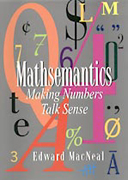
| 1. Hardcover edition, New York: Viking, 1994. ISBN 0-670-85390-9 2. Book Club edition, New York: Viking, 1994, distributed by Quality Paperback Book Club, and by Time Life UK (The Softback Preview), identical in content, page size, and pagination to the hardcover edition, but in soft covers. |
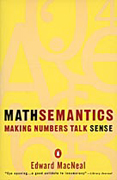
| 3. Paperback edition, New York: Penguin, 1995, identical in content (with minor corrections) and pagination to the hardcover edition, but smaller page size. ISBN 0-14-023486-1 |
Mathsemantics can be purchased at most bookstores and internet retailers. Use the ISBN numbers for hardcover and paperback editions in the Editions section of this page.
The most complete review:
Review: Edward MacNeal, Mathsemantics: Making Numbers Talk Sense,Penguin; 1994 ISBN 0 14023486 1 (24 chapters, Tests, References and Index; 310 pages)
Reviewed by John Gough, Lecturer in Education, Deakin University, Burwood Campus, Victoria, Australia From Vinculum, vol. 33, no. 2, June, 1996, pp 18-23.
Here is a book so strong, clear, and humane it should be set for VCE [Victorian Certificate of Education] English, and could reasonably be used as a mathematics textbook or study-resource from about year 5 to tertiary [higher education]! Strange combination -- like Robert Pirsig's Zen and the Art of Motorcycle Maintenance without the fiction, married to W.W. Sawyer's A Mathematician's Delight, yet with a sense of environmental urgency, a drive to make mathematics save humanity, that Sawyer never dreamed would be needed. It is needed!
Mathsemantics, like John Allen Paulos's stimulating but neglected Innumeracy (Penguin, 1988, about dealing comfortably with fundamental notions of number and chance), is easy to read, challenging, fascinating, and might change the way you teach and the way you think about teaching. Edward MacNeal discusses the connection between mathematics and the meaning of what mathematics deals with. We glibly talk a great deal about emphasising real-world applications of mathematics, the nature of problem solving, the personal construction of mathematical learning, and the need for convincing our students of the fundamental relevance of abstract mathematical concepts and skills. MacNeal's ideas go a long way towards clarifying many of these issues, putting them on a sounder basis, and establishing more constructive ways of approaching the difficulties of communicating between teacher, student, subject and "reality".
Much of MacNeal's discussion arises from the results of a collection of test questions he has used for many years to screen adult job-applicants on the basis of their ability to use mathematics and to think about what they are doing. You might like to try using a version of his test with a class of students from, say, Year 5 to 12, or higher, to see how they compare. As his last chapter suggests, "the mathsemantic ability of our species is so underdeveloped that we should probably regard our ever having-to-rely-on-an-appreciation-of-numbers-for-survival as a sign we're in serious trouble" (p 271). How seriously in trouble are your students?
According to MacNeal, many students experience difficulty in learning mathematics because of confusion between formal mathematics and what the mathematics means, between the written symbols and the translated prose and the ideas they both represent. Here are some closely related examples of similar words with dramatically different mathematical meanings: "5 less than 10" is 5, while (pardon MacNeal's American idiom) "5 less 10" is -5; "6 divided by 2" is 3, whereas "6 divided into 2" is one-third, yet "6 divided into 2 equal parts" is in fact 3 (pp 89-90). To resolve such confusion we need to make mathematics meaningful, and show how language can work mathematically.
MacNeal notes that language acquisition is innate within our species, and then points out that mathematics and semantic (meaning) acquisition is not innate, and depends on deliberate cultural exposure and instruction. He discusses research showing that when humans are presented with pictures of objects too briefly to permit counting, a human glimpse of a collection of objects is no more efficient in recognising how many objects are being shown than is the glimpse by a bird such as a pigeon, a raven or a parrot, who can recognise "numbers" up to 7 with no supporting language. Hence MacNeal's witty summarising Proposition 11: Without language, mathematics is for the birds.
To get a further idea of what MacNeal is concerned about, here are some of his sample arithmetic test questions -- try them on your colleagues and students:
2 apples + 5 oranges = ?
3 one-way trips + 2 round trips = ? round trips
16 travellers x 2.5 hours = ?
2 hrs 12 min / 30 min = ?
Round 0.098 to the nearest whole number
2.0 + .30 + .9 + 106 = ?
To have the best chance of a letter being received in Perth by July 15 you would mail it on:
(A) July 12 (B) July 11 (C) July 10 (D) July 9 (E) July 8
We immediately recognize the hoary old algebra advice: "you can't add apples and oranges". MacNeal's argument is simple -- you can add them, if you know what you mean or what you are doing. For example, a satisfactory "answer" might be "7 pieces of fruit", or "7 objects". Similarly, in the world of airline travel analysis (this is MacNeal's professional area -- he comes to the public arena of education, teaching and learning as an outsider, yet his insight is striking!) a "round" trip is obviously different from a "one-way" trip. What if one or more of the one-way trippers doesn't return? Obviously that can't be combined in any sensible additive way with the trip of a person who returns. Obviously? Well, MacNeal argues convincingly that it can be, and it is, if you know what you mean when you do the "addition".
Yet too often the meaningful basis of categories we are using (such as "apples", "oranges", "one-way" and "return") are neglected in our attempts to discuss and demonstrate abstract mathematics. Too often the categories we are using, in ways that we think we understand, are in fact thought of differently by our students. That is, as MacNeal argues, the meanings we are working with are not clear, are not shared between us and our students, and actually interfere with the development of new understanding in our students. Faulty communication about meaning may act as a block to learning, often even when we are unaware that we, who understand these meanings and take our understanding for granted, are dealing with potentially confuseable meanings at all.
To explain his approach, MacNeal provides one of the most readable discussions I have ever encountered of some of Piaget's ideas about young children's thinking. He combines this with some of Alfred Korzybski's ideas about semantics, the science of meanings in language. Along the way he includes valuable discussion of the mathematics constructivist ideas of Constance Kamii, and many others. This is a hugely readable, often entertaining book. MacNeal may be an outsider to mathematics education, and he is not a mathematician, but he has definitely got his finger on the pulse of mathematics education issues. His account of Kamii's book, Young Children Reinvent Arithmetic (Teachers' College Press; 1985) indicates part of his own message. We are wrong, according to Kamii, to try to teach mathematics as though it were a set of social conventions or extensional facts. It is a way of thinking about abstract systems of relationships. Children must reinvent mathematics in their own heads. For Kamii the key to this is getting children interested in numbers, letting them go at their own speed, keeping them interested, encouraging interaction about numbers with classmates -- as MacNeal summarises the teaching strategy of Kamii and her colleagues, "They gave the children an interesting collection of games and got out of the way" (p 106).
Very briefly, Korzybski's key argument is that our language, such as it is through different stages of our learning development from child to autonomous adult, shapes the way we think in subtle ways usually beyond our everyday awareness. Even the very structure of the language we use influences how we think and how we use our thinking to learn. Consider these bland statements: "It's raining. And my umbrella doesn't want to work. But fortunately the sun is trying to come out." What is this "it" that does the raining? Since when does an umbrella "want" something? Do we really think the sun is "trying"?
At a subtler level, consider this statement: "Here is the number, 2". According to Korzybski, this isn't the number 2, it's not even the numeral, 2, it's simply an example of something we call the numeral 2. Despite these semantic confusions, we hope to communicate shared meaning with our students, building ideas we think we understand, on what seem to us to be ideas our students already possess, using deceptive examples and slippery words whose ambiguity and incorrectness we are unaware of, failing to recognise the fundamental difficulties that may arise, and, instead, talking about our students' "learning difficulties", cognitive confusion, attention deficits, (and in the face of a sentence such as this, how is your attention?) and so on. Related issues arise when we are tempted to confuse a measurement (which is a Korzybskian symbolic statement) with the thing being measured (Korzybski's event), compounded by the need to accept the approximation (due to "experimental error") unavoidably entailed in any attempt to measure, and the need to be clear about what unit is being used (Korzybski's object, a mental construct). These issues are forced on us when we try to teach students to round figures, to work realistically with numbers, to approximate and then report the approximation sensibly (pp 140-143).
One of Korzybski's powerful ideas stresses the difference between an intensional approach and an extensional approach to the related but separate worlds of events (that is, the rather mysterious mishmash of things we believe exists outside of ourselves, not directly knowable, but whose existence is inferred through sensory experience), objects (including constructed images, possibly mental and non-verbal, built from sensory perceptions) and symbols (such as letters and words, but also mathematical signs, pictographs and so on). Incidentally, the spelling of "intensional" with an "s" is intentional.
A person who behaves intensionally will confuse the name (symbol) of something with the thought (object) of the thing and with the thing (event) itself. The children studied by Piaget believed that if they knew the name of something then they knew about the thing, and that the name of a thing was so much of the essence of the thing that the name could not be altered. According to Piaget's children, we could not, for example, decide to call the sun the moon and vice versa, because those are the names of the things and that is what they are. Early scientists behaved in a similar way when they used the name "heat" and, because a name existed for "something", went looking for the substance represented by that name: the result was the phlogiston theory, ultimately replaced by Joseph Priestley's discovery of oxygen and the chemical nature of combustion. Later there was the chimerical search for the "ether", the posited media of propagation of electro-magnetic radiation, which ultimately led to the refutation of Newtonian ether-based theories (in the famous Michelson-Morley experiment) and the first direct experimental confirmation of Einstein's theories of relativity.
A person who behaves extensionally will remain aware of the non-identity of events (that is, that no two different things in the world can be absolutely identical), and objects and symbols. Possible difficulties encountered in clarifying which is event, which is object and which is symbol are dealt with by investigating the words, the symbols, and the world beyond words -- and thereby extending and clarifying the discussion. An intensional approach looks inwardly, seeking to clarify words, explore philosophical subtlety, and relying on reasoning. An extensional approach offers recipes for getting things done, for coping with uncertainty and contradiction, for dealing with the world and its complex relation with language. How extensional or intensional is the process of trying to teach?
MacNeal argues that some of the most powerful lessons that can be learned are essentially extensional, teaching us about the differences between events, objects and symbols, demanding that we learn to be careful, distinguishing what we say, what we mean, what we refer to, stressing the uniqueness of individual things despite their apparent similarity, and showing us ways of handling unique things in meaningfully collected, connected ways. We can add "oranges" and "apples" if we know what we are doing, and to what extent they resemble one another. If we insist strictly on not adding any two things that are different, then we can never add (or do any maths with) any two things. Even two different apples are indeed different, and could not, by that rule, be added, precisely because they are different. If they were "the same" there would only be one. The point of the geometric term "congruence" is that it identifies under what circumstances we can regard two literally different geometric figures as "geometrically identical". Such distinctions are grist for mathematics teachers' mills, but may baffle students.
In chapter 10 MacNeal describes three vivid extensional lessons. When he was about six years old, his accountant father challenged MacNeal and his brother to write whole numbers in sequence: 1, 2, 3, 4, ..., offering a dollar for each number that had only a 1 following by zeros. The two brothers totalled about 60 hours of work, and discovered a great deal about number, positional notation, powers of 10, infinity, uniqueness, pattern, transformation, sequence, "perserverance, and the economics of diminishing returns to scale" (pp 103-104). Another time their father expressed an interest in having the young brothers report to him the results of flipping a coin exactly 1000 times. As a father himself, MacNeal challenged his three- and five-year old children to find a pair of identical objects, rewarding them for each hopeful pair brought forward, but demonstrating (heartless father) the differences which always exist between any two things, however similar looking. The children were learning "that one and one make two different things, that aggregates always involve differences, that all we ever add are apples and oranges" (p 105).
Chapter 11 describes MacNeal's childhood exploration, with his brother, of non-decimal-base arithmetic, discovering for themselves the gap between object (the mental idea, or its verbal or symbolic representation) and event (the thing), discovering that what you call something is arbitrary. Four strokes |||| can be represented as Roman IV, in base ten Hindu-Arabic as 4 or 4 or 4, in French as "quatre", in German "vier", in base 2 as 100, in base 3 as 11, using Dienes MAB blocks as four "minis", on a hand as four extended fingers and a closed thumb, and so on. Yet beneath the symbols, the object (a mental construct abstracted out of real distinct individual events) remains the same. This builds into a discussion of just why 2 times 2 equals 4. The explanation arises from going beyond the words, at Korzybski's symbolic level (and the conventional rule or number fact they state), to understanding at Korzybski's level of events that the words "times two" means "taking twice" or "putting together two lots of" whatever is being dealt with. Proposition 15: Until you work it out for yourself, two times two makes four only because the teacher says so. You have to do multiplication before you can understand what it means.
Remember the rounding question at the beginning: round 0.098 to the nearest whole number? Many people have difficulty rounding to zero. Why? It seems they feel zero is not a number. As an example of MacNeal's wit, and constructive analysis, consider one of his many summary points, Proposition 10: "Nothing is a mathsemantic problem" (p 84). Nice pun! He is actually referring to conceptual difficulties people (from children to adults) experience with the concept of zero. Consider these possible replies to a typical mathematics question:
Q: "Does the equation have a number of solutions?"
A: "No, only one"; or,
A: "No, there is no solution".
These two different examples of language usage (there is one solution, or the number of solutions is zero) suggest that 1 and 0 are not "numbers". The point is Korzybskian: language is slippery. The word "number", semantically and cognitively, is used by mathematicians, and others, to refer to many different things, often related (wholes, cardinal, ordinal, fractions, evens, primes, irrationals, transcendentals, imaginary, complex, transfinite), "some of which are nearer the central, prototypical meaning ... than others. Thus, instead of separate categories of absolute equals, we have related usages with shades of meaning. Less rigidity, more feely-interpretation." (p 129). Hence, zero is a number, but is not prototypical of "number". Similarly, for Aristotle, 1 was not a number in itself, but the unit by which "numbers" (i.e. pluralities of wholes) were measured.
MacNeal argues that such persistent linguistic confusion derives ultimately from our cultural inheritance of mathematics from the Ancient Greeks, who refused on philosophical grounds to work with "nothing", despite the later superficial overlay of the Hindu-Arabic "zero" on our fundamentally Western Graeco-Roman culture. He also mentions the laws passed in Medieval Europe banning the use of the Hindu-Arabic number system in favour of the hopelessly clumsy Roman system (p 116). He urges that to solve these difficulties we need to accept the naturalness and importance of zero, emphasising it in these ways:
-- put a 0 at the left end of every ruler,
-- start counting with zero, in print and orally,
-- put "zero is a number" into school policy,
-- display in every classroom a large dummy thermometer
with a prominent zero and a moveable degrees pointer,
-- speak of children younger than 1 as zero-year olds (pp 83-84).
Elsewhere his research suggests that people who use commas to separate millions from thousands and thousands from hundreds handle mathematics tasks better than people who do not use commas (pp 178-179).
MacNeal's discussion of percentages (chapter 22) extends Paulos's wicked remark that when he (Paulos) hears that something is selling for a fraction of its normal cost he comments "that the fraction is probably 4/3" (p 122). Emphasising a commonsense approach to percentages (parts out of a hundred, as the Latin term literally translates), and suggesting that we can teach the mechanical concept in about five minutes and the rest is just experience, MacNeal poses these percentage questions: If sales drop by 20% then rise by 25%, how are we doing? What about a drop of 70% and a rebound of 80%? Or a profit of 80% followed by a loss of 70%? His teaching tip is to work these out step by step, as the questions suggest, starting with a notional $100, and observe the successive changes. Try converting 12/3 to a percentage, or convert 0.814 to the nearest whole percent.
Here MacNeal's emphasis on the equivalent meaning of alternative notations and words, a common feature in mathematics, clearly shows the need to practise translating from one form to the other, fraction to percent to decimal, and so on, in every possible direction of translation. What is the flaw in this argument: 49% of males like vanilla icecream and 21% of females like vanilla icecream, therefore seven out of ten people like vanilla icecream (p 249)? What about the horse-and-rabbit stew, whose recipe requires a fifty-fifty proportion of horse and rabbit: one horse to one rabbit (p 249)! Such examples indicate the complicated interaction between meaning and arithmetic or mathematics (i.e. mathsemantics!) which arises in percentage ideas as soon as we go beyond the merely mechanical level. No wonder students find using percentages can be tricky. Proposition 27: Percentages are dangerous social and economic tools that appear easy only to math teachers and the inexperienced.
This leads to a discussion of surveys and sampling, with a chilling implication for educational research. Evidence adduced from small trials will be less reliable than evidence based on larger trials. The reason comes from the correct answer to another of MacNeal's questions: Which is generally the most important in determining the reliability of a sample? (a) the absolute size of the sample, (b) the percentage which the sample is of the entire population, or (c) the absolute size of the entire population (pp 257, 259). Yet MacNeal also recommends the critical pooling of many modest sets of related data, rather than attempts to establish one grand conclusive-for-all-time study (p 262). In the light of MacNeal's intriguing discussion of mathematics, meaning, statistics and surveying, I remind readers of John Price's superb piece of mathematically-based possum stirring in the last issue ofVinculum (vol. 33, no. 1 1996 6-9), "School-Based Parent Satisfaction Monitoring: a Statistical Trap"!
MacNeal even contributes to the search for eminent females in mathematics, quoting at length from a biographical article in the American Statistician (May 1990) about Florence Nightingale, famous as a pioneer nurse, but less famous as a statistician. Yet she is a major pioneer in the field, lauded as a "prophetess" in the development of applied statistics by no less a statistical luminary than Karl Pearson -- momentous praise, indeed (pp 254- 255)! And because statisticians are not the most famous people on Earth, and because the Japanese are running economic rings around us, you might like to read MacNeal's comments about the world-changing influence of statistician W. Edwards Deming in Japan. Who? Deming is best known for work on "quality control".
About half way through the book, discussing issues of numeracy (including notoriously vague definitions, and inadequate research data) and the differences between "pure" and "applied" maths and the fact that neither fits well with fuzzy human thinking and living, MacNeal directly addresses teachers. "We must face up to teaching math (1) as a pure symbol-system, (2) as a symbol system we can apply to events at our own risk, and (3) as an adventure in crossing fuzzy boundaries between the pure and applied domains" (p 134), blending "a desire for internal consistency with unavoidable approximations and definitional uncertainties" (p 135). MacNeal says to us: "If we discover now that I'm wrong, we'll both be better off ... you should apply it to this book" (p 111). Some book! Try it. As MacNeal stresses: we are "all going to be judged in the marketplace by the cost of our services to clients and by how well we [survive] the witness stand" (p 178). Moreover, "Unfortunately, most of the serious threats to our species involve measurement, large numbers, or both" (p 146). Good mathsemantical thinking is more urgently needed than ever before!
Articles in the Mathsemantic-Monitor series:
All the articles below have appeared in the continuing Mathsemantic-Monitor series in ETC: A Review of General Semantics. The title and subject of each article is given followed by the ETC volume and number, season and year.
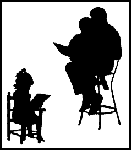
1.
"80,000 Books": The habit of counting actions as things (objectifying actions) has several unfortunate mathsemantic consequences. The discussion builds on a school principal's challenge to students that he will sit on the roof for a day if they read 80,000 books that year. (50.2, Summer 1993)
2.
"The Great Eskimo Vocabulary Hoax": Whorf's report of the number of words that Eskimos have for snow, which lacked a proper foundation to begin with, quickly got completely out of hand. And it would appear that nobody has yet found a mathsemantically reasonable way to count words for "snow." (50.3, Fall 1993)
3.
"Financial Bombs": Reporting nominal monetary figures for different years invites unjustified conclusions. The discussion builds on a New Yorker story that compared, without adjustment for inflation, the $200,000 reward offered after the 1993 bombing of the parking garage at the World Trade Center with the $20,000 reward offered after the 1920 Wall Street bombing. (50.4, Winter 1993)
4.
"Millions-Billions": The problems people have with large numbers and mathsemantics presently carry no burden of political or social incorrectness. The discussion builds on a Newsweek correspondent's report that "Last year, nearly 2.6 billion passengers rode the Moscow subway." (51.1, Spring 1994)
5.
"Educated for What?": The American mathematics-industry's recent promotion of fears over a lack of students of higher math was misleading. Even the roughly 1,200 math PhDs produced a year in the country have trouble finding useful employment. We could more reasonably shift our attention from trying to encourage more students to enter higher math to the mathsemantics failings of students at large. (51.2, Summer 1994)
6.
"Nothing at All": People's disagreement over whether zero is a number leads to practical failures in communication. The discussion builds on a large retailer's notice that it would "impose a minimum Finance Charge of $.50 whenever the Average Daily Balance of your account is $28.50 or less." (52.1, Spring 1995)
7.
"One More Time": The common verbal construction "times more" is often more than just ambiguous. Take the words of a reviewer of Erika Jong's Fears of Fifty: A Midlife Memoir, that "Jong has been married three times more than I have...." Depending on how many times the reviewer has been married, this can lead one to calculate that Jong has been married three, four, five, six, eight (or more) times. (52.2, Summer 1995)
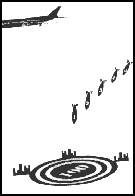
8.
"Looking Ahead: Why the Real Lesson of Vietnam Eludes Robert McNamara": A problem-solving (goal-directed) framework supported by a mathematical outlook tends to limit the review of available options and factors to those that are measurable relative to a predetermined goal. The discussion uses McNamara's 1995 book, In Retrospect: The Tragedy and Lesson of Vietnam, to show that he still failed at that time to grasp the power of this tendency. (52.3, Fall 1995)
9.
"The Power of Powers: Schemes, Scams, and Panties": How a failure to understand the rapid growth of phenomena that are subject to repeated doublings or higher powers opens the way to chain letters, Ponzi schemes, and other scams. The article ends with a discussion of the then-current, based-near-here, let-our-anonymous-benefactors-double-your- nonprofit-organization's-funds-in-six-months "New Era Philanthropy" scam. It seems that the perpetrator didn't understand the scam. Otherwise why did he use a good bit of the cash to buy a house here in which he apparently expected to live with his family for many years? (52.4, Winter 1995- 96)
10.
"Natural Wonders": Counts of actions are not people. The discussion builds on a telephone-company advertisement sent by a mathsemantic monitor in New Zealand, which ad claimed that "Over 20 million people called this [the New Zealand Telecom] number last year." The problem is that only 3 million people live in New Zealand. (53.1, Spring 1996)
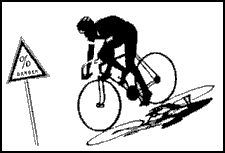
11.
"Playing the Percentages: Sex in Connecticut": People produce weird results with percentages. The article builds on two stories in Connecticut papers sent in by two different mathsemantic monitors there. The first announced that "92% of young men have AIDS virus" rather than the correct and bad enough, "one of every 92 has AIDS." The second story reported that rape in Torrington, Connecticut, had dropped 450% between 1994 and 1995, raising the interesting question of what negative rape might be. (53.3, Fall 1996)
12.
"On Having Four Feet": The discussion builds on Marilyn Shatz's A Toddler's Life: Becoming a Person. Toddlers have at least three separate number domains: counting (as a motor act), plurality (as "more than one"), and a number lexicon (as distinct from a color lexicon, for example). But unlike adults, toddlers can't reason from one domain to another. Thus, for example, toddlers can count their own feet, "one, two" and still reply "four" when asked how many feet they have. (53.4, Winter 1996-97)
13.
"Fatal Words": Bad mathsemantics can have fatal results. The discussion includes how "empty" oxygen canisters were implicated in the Valu-Jet flight-592 crash in the Florida Everglades in 1996 with the loss of all 110 persons aboard, how Whorf had noted danger in the term "empty" in 1939, and how Cushing's 1994 book, Fatal Words: Communication Clashes and Aircraft Crashes, provides many examples of dangerous mathsemantic misunderstandings, while, sadly, failing to integrate findings from studies by Whorf and others. (54.1, Spring 1997)

14.
"A Sporting Proposition": Sportswriting exhibits many different kinds of mathsemantic error. In American baseball statistics, for example, a good batter may be reported as batting better than 300 percent, which is listed in tables as ".300 pct," two contradictory and individually absurd constructions. The Mathsemantic Monitor's offer to donate 100 hours of his time to improve the sports-math section of the copybook of any English-language daily paper expired after one year with no takers. (54.2, Summer 1997)
15.
"House Seats": Numbers can't be rounded in such a way that their original ratios to each other are retained. Hence, in specifying that "Representatives . . . shall be apportioned among the several states . . . according to their respective number," the framers of the U.S. constitution bequeathed two enduring mathsemantic problems to the nation. The first is how to take a practical census. The second is how to treat the census counts mathematically to make the apportionment. (54.4, Winter 1997)
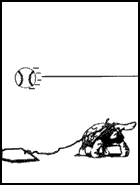
16.
"Shifting Base": Statistical compilations need to deal properly with the bases of the statistics. The discussion builds on various reports, such as the relationship of sexual activity to mortality, the fat in margarine, college attendance, the effectiveness of psychotherapy, immigration rates, cancer rates, and so on. (55.1, Spring 1998)
17.
"Number-English: A Dictionary (A-Alg)": Hitching math to English creates problems. This article presents the first installment ("A, An" through "Algorithm"). Based on this and two further installments, a university's publishing arm made a publishing offer (for a complete book) that gave, regretfully, insufficient incentive for the Mathsemantic Monitor to complete this enormous project. (55.2, Summer 1998)
18.
"Number-English: A Dictionary (All-Ant)": This is the second installment ("All" through "Antepenultimate"). The projected book would cover all the mathsemantic problems in Mathsemantics and the mathsemantic-monitor series plus many more, with discussions of mathsemantic categories, such as that of "vector." Asked, for example, "How old is he?" the answer "About thirty" has no vector, whereas "Almost thirty" does, namely, up from zero. "Ago" has the vector from now toward then, whereas "since" has the vector from then toward now. Put together, the vectors jar, hence make bad English. "It's been 25 years ago since he graduated. (55.3, Fall 1998)
19.
"Number-English: A Dictionary (Any-Az)": This is the third installment ("Any" through "Azimuth"). Its discussions fall under such headings (a sample only) as "Any Of," "Apples and Oranges," "Arabic Numerals," "Arithmetic," "Around," "Array," "As...As," "Assumption," "As Well As," "At Least," "Attendance," and "Average." (56.1, Spring 1999)
20.
"Grokdueling": Most arguments fail to demonstrate that any party truly understands the point of view of the others. In a grokduel the contestants vie to see who understands the others. The discussion builds on the findings of Robert S. Siegler of Carnegie Mellon University that the children who learned conservation of number the fastest were in the group asked to explain the experimenter's reasoning. (56.2, Summer 1999)
21.
"One Person-One Vote": A simple spreadsheet algorithm can reduce any set of figures to a smaller set of rounded figures to fit a given total in a way that minimizes the absolute deviation of the unrounded/rounded ratio from the average. This is a return to the question raised but left unanswered in article #15, "House Seats." (56.3, Fall 1999)
22.
"Review of Mathsemantics": John Gough, the author of this review originally published in 1996 in Vinculum, an Australian mathematics-education journal finds MacNeal's Mathsemantics: Making Number Talk Sense "so strong, clear, and humane it should be set for VCE [Victorian Certificate of Education] English, and could reasonably be used as a mathematics textbook or study resource from about year 5 to tertiary [higher education]. (57.2, Summer 2000)
23.
"Gen-Spec": The separation of ordinary language from that of math resembles the separation of Dictionopolis from Digitopolis in The Phantom Tollbooth. Mathsemantics requires the blending of both English and math. The poor mathsemantic ability of the public at large is not the fault of math education alone. (in press)
List last updated 10/23/00
Links:
Complete review summarized in #22 above.
Further reader comments on Mathsemantics.
ETC managing office to request a sample copy of ETC.
ETC managing office to buy issues containing Mathsemantics-Monitor articles.
Mathsemantic-Monitor series editor to comment on an article.
Mathsemantic-Monitor series editor to submit an item of potential interest for the series
Mathsemantic-Monitor series editor to propose or submit an article for the series